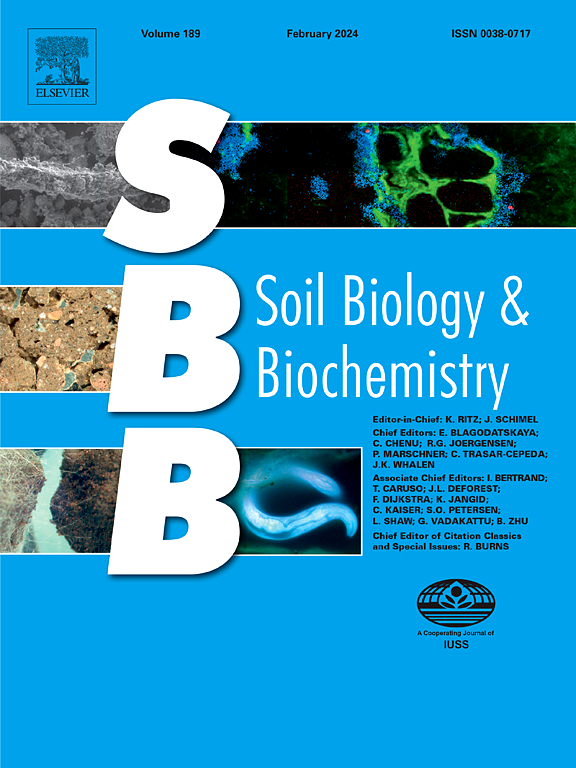决定残留物融入 SOC 池的是植物器官而非覆盖作物种类
IF 9.8
1区 农林科学
Q1 SOIL SCIENCE
引用次数: 0
摘要
种植覆盖作物已成为提高土壤有机碳(SOC)储量的一种很有前景的方法,尤其是豆科植物等优质残留物被认为具有更高的碳利用效率。在这项研究中,我们探讨了不同的覆盖作物残留物,特别是豆科和禾本科覆盖作物的残留物,如何影响 SOC 的形成及其在各种土壤碳库中的分布。在为期 7 个月的时间里,我们将 14C 标记的冬黑麦和毛茸茸的薇菜残留物放入含有来自长期田间试验的不同土壤肥力水平的土壤的微生态系统中进行培养。尽管在碳氮比、化学成分和周转率方面存在显著差异,但在每个植物器官(芽和根)内,我们观察到野豌豆和黑麦的 SOC 形成效率相似。有趣的是,植物器官似乎比豆科或非豆科作物对覆盖作物碳的去向影响更大。在中等肥力的土壤中,我们发现覆盖作物残留碳的最大比例是 MAOM(芽为 20%,根为 15-18%),其次是 fPOM(芽为 5-6%,根为 10-12%)和 oPOM(芽为 2.7-3.0%,根为 1.5-1.6%)。值得注意的是,fPOM 和 oPOM 对残留物质量的反应截然相反,这表明这些经常汇集在一起的 POM 池之间存在着功能差异。本文章由计算机程序翻译,如有差异,请以英文原文为准。
Plant organ rather than cover crop species determines residue incorporation into SOC pools
The implementation of cover crops has emerged as a promising approach to improve soil organic carbon (SOC) stocks, with particular emphasis on the perceived higher carbon use efficiency displayed by high-quality residues such as from leguminous plants. In this study, we explored how different cover crop residues, specifically from a legume and a grass cover crop, affects SOC formation and its distribution across various soil carbon pools. Over a 7-month period, we incubated 14C-labeled winter rye and hairy vetch residues in microcosms containing soils of varying soil fertility levels from a long-term field trial. We tracked the fate of carbon into free and occluded particulate organic matter (fPOM, oPOM), mineral-associated organic matter (MAOM), and carbon deposited outside the detritusphere.
Despite notable differences in C:N ratio, chemical composition, and turnover rate, similar SOC formation efficiency between vetch and rye within each plant organ (shoots and roots) was observed. Interestingly, the plant organ appeared to exert a greater influence on the fate of cover crop carbon than whether the crop was leguminous or non-leguminous. This phenomenon seemed to be closely related to the lignin content.
At medium soil fertility, we found that the largest proportion of cover crop residue C remained as MAOM (20% for shoots, 15–18% for roots), followed by fPOM (5–6% for shoots, 10–12% for roots) and oPOM (2.7–3.0% for shoots, 1.5–1.6% for roots). Notably, fPOM and oPOM exhibited opposite responses to residue quality, indicating functional distinctions between these often-pooled POM pools.
Soil fertility exerted minimal influence on overall respiration rate patterns or SOC formation, although it did affect oPOM formation efficiency, likely due to differences in soil aggregation.
In conclusion, our findings challenge the assumption regarding the superiority of N rich leguminous cover crop residues for enhancing SOC accrual in C pools believed to have longer persistence.
求助全文
通过发布文献求助,成功后即可免费获取论文全文。
去求助
来源期刊

Soil Biology & Biochemistry
农林科学-土壤科学
CiteScore
16.90
自引率
9.30%
发文量
312
审稿时长
49 days
期刊介绍:
Soil Biology & Biochemistry publishes original research articles of international significance focusing on biological processes in soil and their applications to soil and environmental quality. Major topics include the ecology and biochemical processes of soil organisms, their effects on the environment, and interactions with plants. The journal also welcomes state-of-the-art reviews and discussions on contemporary research in soil biology and biochemistry.
 求助内容:
求助内容: 应助结果提醒方式:
应助结果提醒方式:


